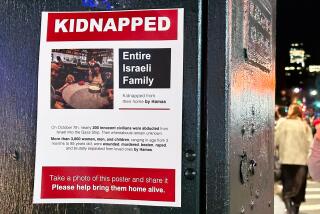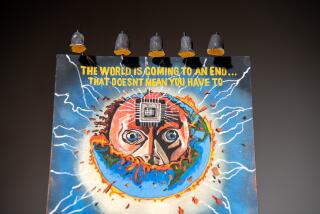Wanted Posters : Former Boy Scout Steve Turner Has Switched From the Art of Tracking to the Tracking of Art
- Share via
Few people develop a burning interest in art through the Boy Scout movement. Lighting fires by rubbing sticks together, yes. Learning how to tie a reef knot instead of a granny, yes. But judging the finer points of a Vermeer or a Matisse? Not really.
There is an exception. Steve Turner, a 26-year-old Studio City attorney, began by collecting Scout badges; but, by a series of shifts of interest, he has become a collector of Danish posters from the 1890s on. He has switched from the art of tracking to the tracking of art.
Like millions of boys who were not destined to become art connoisseurs, Turner was a Scout. In 1973 he attended a national jamboree in Farragut, Ida., a gathering of Scouts from all over the United States. At the event he began to collect, in a haphazard way, badges from other places--for example, one that identified “Boy Scouts of Cleveland.” He took addresses and corresponded with other scouts.
Turner became more ambitious and bought whole collections of badges. He added to his hoard other artifacts associated with the Scout movement, including posters. One poster he bought was designed during World War I by the founder of the Boy Scouts, the then Lt. Gen. Sir Robert Baden-Powell of England. With the caption “Are YOU in this?” it depicts people contributing to the war effort.
As his collecting became more sophisticated, Turner decided to specialize in artifacts made for world Scout jamborees. The first such jamboree was held in London in 1920, and was attended by 500 Americans. “I did some research in the United States, mainly in California,” Turner says, “and tried to find some of the world jamboree artifacts. I quickly learned that to achieve something comprehensive I could not remain solely in the United States, so I ventured abroad.”
In 1983 Turner went to Denmark with a friend who happened to speak Danish. “The second world jamboree was held near Copenhagen in 1924,” Turner explains. “It was the smallest jamboree ever held; only 60 Americans attended.” The participants’ badge, which is the central item in any display of world-jamboree material, was made of raw silk. By word of mouth, Turner located a Dane who had attended the 1924 jamboree. “He was very happy to let me have his badge for my projects. He said: ‘No one has ever spoken to me about it since 1924; take it with my best wishes.’ ” Turner began keeping what now amount to hundreds of files on former Scouts. “One former Scout, who was 18 in 1924 and is now 80 and terribly sharp, met me for a beer in Copenhagen and even typed up three pages of recollections about that jamboree.”
In 1984, Turner’s interest in posters was rekindled by the Olympic Games posters that were appearing in Los Angeles. “There were two exhibitions of old Olympic posters in commercial art galleries. I knew that I could find posters of similar quality in Europe. Having sought out something as recherche as a raw-silk badge from a 1924 jamboree, I knew that I could find old Olympic Games posters without any trouble.” He sought out Los Angeles dealers and collectors who specialized in posters. “I wanted to find out what made posters desirable, what made them good. What did the collectors see that I didn’t see?”
Armed with his new discrimination, Turner revisited Denmark in the fall of 1985. He had found very little written on Danish posters--only a 1952 pamphlet and a couple of brochures by Danish printing firms. But he hunted in bookstores, flea markets and antique shops, trying to track down anyone who might own good Danish posters. He was especially keen to acquire posters by turn-of-the-century master J. F. Willumsen, who had studied with Gauguin in Paris. Turner obtained an introduction to Willumsen’s grandson, also an artist, who was glad to sell some of the posters he had inherited, including a 1910 poster on which J. F. Willumsen portrayed himself painting a nude model.
Another Danish poster artist whose works Turner coveted was Sven Brasch, who worked mainly in a bold and vivacious Art Deco style. Brasch’s clients were film companies, theaters, cafes and airlines. Turner also met and bought posters from descendants of artists Thor Bogelund and Arne Ungermann.
Turner has now become so infatuated with Danish posters that he wants to arrange an exhibition of about 100 examples--some from his own collection, some from institutions--to travel to several American museums. I asked if he could summarize what it is that distinguishes the Danish poster from posters of other nations. “It has a spirit that is the Danish people; it is hard to quantify that--a friendliness, a comical nature. And there is an elegance to Copenhagen that is captured in the 1920s and ‘30s examples. Denmark is joined to Germany; it is very much a part of the Continent, and Danish poster art reflects French and German influences. A lot of the designers studied in Paris.”
Turner heard in May that he had passed the California Bar examination. Having been a good basketball player until his left knee was damaged in a 1979 car crash, he had always intended to represent basketball players. But he has been disenchanted by the controversies in professional sports--drug abuse and unethical behavior by agents. He thinks he may now represent artists instead, at least for 20% of his time.
Steve Turner has not abandoned his original interest, the Boy Scout movement. He is writing a book on world Scout jamborees. He hopes he can persuade the Hungarian government to assist him in researching the 1933 world jamboree, which was held outside Budapest.
“It was an important prewar jamboree. I have good information on it, but I don’t have the depth. I haven’t met with people who were on the staff at it; I haven’t met with hundreds of participants. I would like to go to Hungary and research there for a month--travel freely throughout the country, not just through Budapest.”
If Turner achieves that ambition, a whole new interest in Hungarian posters will no doubt burgeon.
More to Read
Sign up for The Wild
We’ll help you find the best places to hike, bike and run, as well as the perfect silent spots for meditation and yoga.
You may occasionally receive promotional content from the Los Angeles Times.






